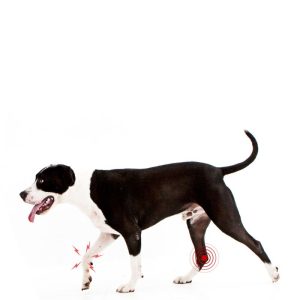
Pain in dogs
What to do
Causes
When to worry
Prevention
Diagnosis
Home treatment
Vet treatment
Risk
Other causes

Pain in dogs
There are many different causes of pain in dogs. Dogs don’t often show pain in the way we expect. The symptoms of pain can appear as physical and behavioural changes and can affect dogs of any age. Dogs try to hide when they are in pain, so the signs may be subtle.
Pain can range from mild to severe and can be acute (short-term) or chronic (long-term).
Many human pain relief medications are toxic to dogs. Do not give your dog any human pain medication without speaking to a veterinarian.
What to do if your dog is in pain
If your dog is showing signs of pain, speak with a veterinarian.
They will be able to:
Determine if they need a physical appointment and any further tests.
Determine if they need pain relief.
In the meantime, make sure your dog has somewhere quiet and comfortable to rest. Avoid touching any painful areas.
How to know if your dog is in pain
Physical signs of pain
Limping, stiffness, or moving more slowly
Not eating or drinking
Licking or biting at certain areas of the body
-
Panting more than normal

Holding up a limb indicates pain
Behavioural signs of pain
Lethargy or tiredness
Sleeping more than normal
Growling and aggression
Seeking more attention than usual
Shaking and trembling
Pacing and restlessness
Vocalising more, yelping, whining, or howling
Avoiding climbing stairs or reluctance to jump on the sofa or in the car
Facial expressions associated with pain
Grimace, wide-eyed, flattened ears, and tense facial muscles.
Body language associated with pain
-
Hunched posture, yawning, licking lips, praying position, and flinching when approached or touched.

Prayer position can indicate pain

Most common causes of pain in dogs
There are many different causes of pain in dogs. The most common causes include:
Sprains and strains which can cause Limping
Skin and ear infections
Dental disease, Bad breath
Pain after surgical procedures
Spinal disease, such as disc disease
When you should be worried about pain in dogs
Seek help from a vet if
Your dog is unable to put any weight on one or more of their legs.
Your dog needs pain relief.
Your dog has suddenly become aggressive but hasn’t had a physical exam in the last 6-12 months.
Joii can help if
You are unsure if your dog is in pain.
You have any questions about joint or other supplements in dogs.
You have any questions about tooth brushing in dogs.
You need advice about how to help your dog lose weight.
Your dog is showing mild signs of pain and you are unsure what to do.
Tips on how to prevent your dog from being in pain
Not all types of pain are preventable. Seek help from a veterinarian at the first sign of pain developing. Early treatment results in a better outlook.
Joint supplements can help with mobility and stiff joints. Some supplements can help with skin, urinary, dental, and digestive diseases.
Clean your dog’s teeth regularly from a young age.
Keep exercise regular and controlled. Avoid sharp stops and repetitive movements. Growing joints in puppies are more vulnerable.
Avoid breeding dogs with progressive and severe joint diseases.
Keep your dog at a healthy body weight and feed good-quality, complete food.
Diagnosis of the different causes of pain
The following tests may be performed to find out what is causing the pain
A full physical examination
Blood and urine tests
Imaging, such as x-rays, ultrasound, CT or MRI scan
How to help your dog at home if they are in pain
You can help your dog recover at home when they are in pain in many different ways.
Allow them to rest. Make sure they have somewhere comfortable and quiet to sleep.
Keep food and water easily accessible.
Give any medication as advised by your vet. Keep to the correct dose and time as advised. Unfortunately, there are no home remedies that can be used as pain relief.
Painkillers for dogs are only available on prescription. Do not give any human medications unless advised by your veterinarian. https://www.vpisglobal.com/common-poisons/
Heat packs are useful for muscle pain and joint stiffness. Ice packs are useful to help reduce inflammation and pain in a recent injury. Wrap the packs in a towel to avoid any discomfort for your dog.
Supplements may be helpful for certain problems, such as joint or skin conditions.
Controlled or zero exercise is recommended if the pain is due to a musculoskeletal or neurological disorder. This includes arthritis, disc disease, and soft tissue injuries.
Monitor your dog carefully. If they still seem to be in pain despite treatment, speak to your vet. They may need different medications or doses throughout the process.
Vet treatment of pain in dogs
The treatment will depend on the cause of the pain. Several different treatments may be required at the same time. Some dogs may need hospitalisation for monitoring until they are stable.
Pain relief
There are many different types of pain relief medications available for dogs. The type prescribed by your vet will depend on how severe the pain is, the cause, and the location.
Pain relief doses may need to be changed or new medications added along the way, depending on how the disease progresses or improves.
Pain relief medications for dogs include NSAIDs (non-steroidal anti-inflammatories), opioids, gabapentin, amantadine, and others.
Other medications
Used to treat the root cause of the pain
Antibiotics or antifungals
Anti-itch medications
Medication for the digestive tract, such as anti-nausea or antacids
Surgery
If the cause of pain is
Dental disease
Spinal problems
Fractures or dislocations
Wounds
Complementary therapies
Acupuncture
Available from specially trained veterinarians in the UK. Commonly used to help with pain, specifically longer-term pain such as arthritis. Helpful for other diseases too. http://www.abva.co.uk/
Physiotherapy
Useful to help recovery after surgery or an illness. Should be done by trained professionals, you can find them on the following website. http://www.rampregister.org/
Hydrotherapy
Useful for a variety of conditions such as spinal disease, arthritis, and soft tissue injuries. Should be done by trained professionals, you can find them on the following website. http://www.narch.org.uk/
Laser therapy
To reduce pain and inflammation, often alongside pain medications.
Are some dogs more at risk of pain than others?
Dogs of all breeds, ages, and genders can develop pain. Specific causes of pain may be more common in some dogs than others. Sprains
Older dogs
Overweight dogs
Very active dogs
Arthritis
Overweight dogs
Dogs with developmental joint problems, such as elbow or hip dysplasia
Dogs that have had a previous injury, trauma or surgery involving a joint
Certain breeds, such as Rottweiler, Labrador and German Shepherd
Dental disease
Older dogs
Smaller breeds such as Chihuahua, King Charles Spaniel, and Toy Poodles.
Greyhounds and spaniel breeds are also at a higher risk.
Back and spinal disease
Dachshunds, German Shepherds, Cavalier King Charles and Bulldogs are at a higher risk.
Other causes of pain in dogs
Urinary tract infections

















